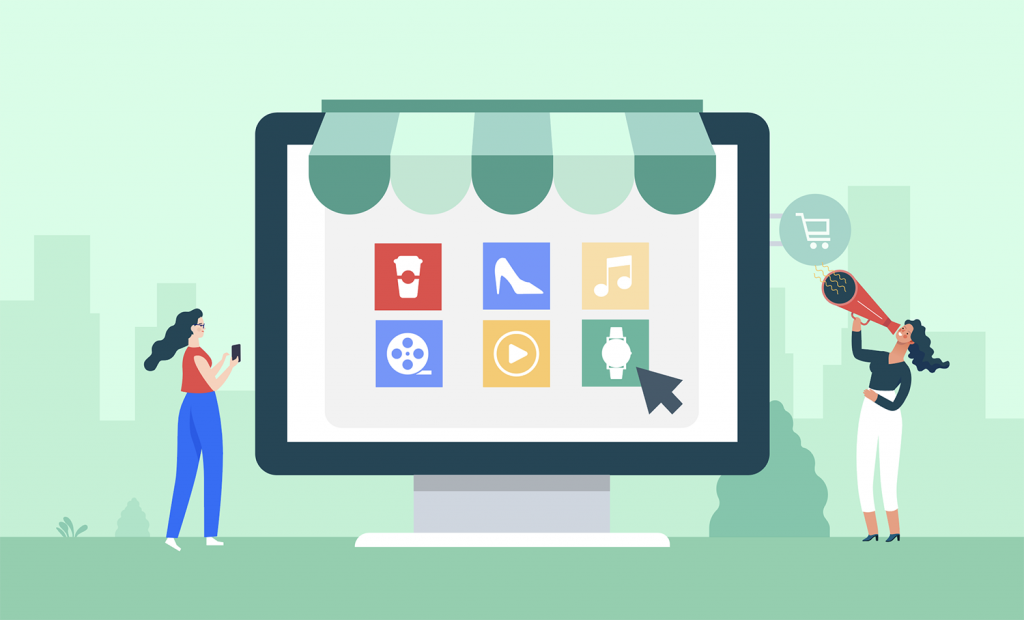B2C Marketing: A Comprehensive Guide
No business-to-consumer (B2C) company could survive —never mind thrive— without doing some kind of marketing. B2C marketing, which differs from business-to-business (B2B) marketing in that it focuses on promoting goods and services to individual consumers (rather than other organizations), is the wizardry that makes a company both visible and attractive to their target audience.

It’s how you create interest in your offering, how you bring in new customers (acquisition), how you hold onto existing ones (retention), how you boost sales, and how you turn your hard work into profit. It is, in many ways, the lifeblood of a business.
But “doing” B2C marketing isn’t as simple as shouting from the rooftops about your new clothing line or app. You need to know who you’re talking to. You need to be familiar with the channels available to you. And fortunately, thanks to digital transformation, there are now plenty.
The rise of online media and technologies has laid the foundation for a heap of new ways to engage with customers — alternatives that allow for greater personalization, interactivity, automation, and measurability. Think social media marketing, email marketing, video marketing, etc.
A world of possibilities awaits you. But where do you start? That’s where this guide comes in.
We’ll discuss the B2C model, highlight the differences between B2B and B2C marketing, and review some of the most effective B2C marketing channels. We’ll also explore various tried-and-tested tactics and strategies that business owners and marketing professionals can apply today to achieve results tomorrow. By the end, you should be well positioned to help your company not just survive but thrive.
What is B2C marketing?
Before diving into the ins and outs of B2C marketing, it’s worth exploring what B2C is more generally. After all, you need a clear understanding of this professional operating model in order to target your B2C marketing efforts more effectively.
Broadly speaking, B2C business refers to commercial transactions and exchanges between companies and individual consumers. B2C companies sell products and services directly to the public for personal use, often via an online platform. The everyday consumer as the target market is what ultimately differentiates B2C enterprises from business-to-business (B2B) companies, which, as the name suggests, focus on selling their wares to other companies.
Apple, Tesco, Starbucks, Amazon, YouTube, and Lyft are just a few examples of successful B2C businesses.
The B2C business model: Definitions, considerations, types, and examples
While definitions of the term “business model” vary widely, it’s helpful to think of the concept as a framework that outlines how an enterprise operates, how it makes money, who it caters to, and how it creates and delivers value to customers.
A business operating under a B2C business model earns revenue by catering to the needs and wants of everyday individuals. Over time, many different types of business models have popped up under the B2C umbrella, especially as new digital technologies and platforms have created novel means of making money.
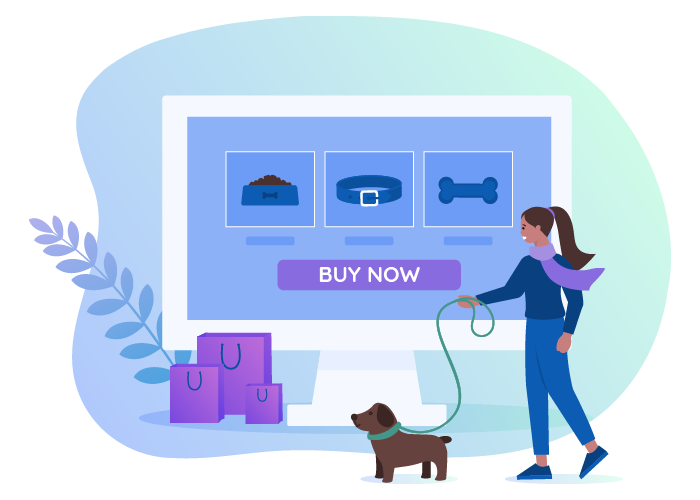
Whatever sort of B2C model your company subscribes to, it’s critical that you have a good grasp of what it entails and what kind of assumptions it makes so that you can design a marketing campaign that will achieve results. Naturally, it would be nearly impossible to develop targeted messaging that appeals to your audience if you don’t fully understand what your customers consider important and how your company is set up to solve key problems.
Developing a sound understanding of your B2C business model
Swiss business theorist and consultant Alexander Osterwalder developed a “business model canvas” that helps founders of both small startups and large enterprises choose the right model for their business, refine hypotheses about their company’s operating structure, and better understand their value proposition.
He recommends asking the following questions (among others) to improve your understanding of what makes your organization tick (and, as a result, your ability to market it effectively):
- Who are our most important customers?
- Which one of our customers’ problems are we helping to solve?
- What are our customers really willing to pay for?
- What do they currently pay for?
- What key activities do our value propositions require?
- What key resources do our value propositions require?
- Through which channels do our customer segments want to be reached?
- How do other companies reach them now?
5 successful B2C business models for profit seekers
If you’re not sure which B2C business model is the best option for your business, you might find it useful to consider some of the most popular and successful models out there today. Below you’ll find five options: Weigh the pros and cons of each when deciding what works for you, and use this information to design both a sound commercial framework and a winning B2C marketing strategy.
- Freemium model
- Subscription model
- Advertising revenue model
- Marketplace/ platform-based/ brokerage / aggregator model
- Razor-razor blade model

1. Freemium model. Customers can access the basic product/service for free but must pay for additional (premium) features and functionality.
Pros:
- Easy to get a foot in the door: Customers are more open to trying out products/services when there’s no fee attached
- Once buyers are hooked on your offering, it’s not too difficult to convert them to paid plans
- Fairly easy to obtain word-of-mouth marketing exposure
Cons:
- You can fall into the trap of giving away too much for free.
- Constant innovation is required to keep increasing the value of premium services.
- Costs can outweigh earnings in the early stages of business.
Examples: LinkedIn, Dropbox, Spotify
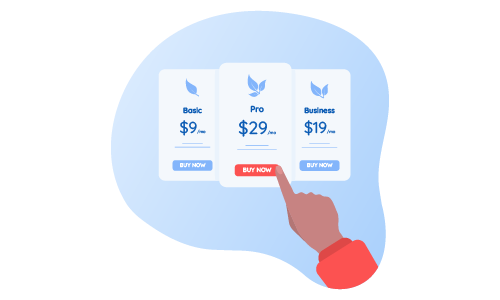
2. Subscription model. Rather than paying a high price once, customers pay a recurring flat fee (every month or year) for consistent access to a service/product.
Pros:
- Fairly predictable and reliable income stream
- Improved customer retention
- Ongoing servicing allows for close study of customer behavior over time
Cons:
- Small issues can disrupt an entire product/service delivery cycle.
- Most customers are only willing to subscribe to a limited number of services (so the pool of prospects is smaller).
Examples: Netflix, Adobe, Birchbox
3. Advertising revenue model. Customers get the product/service for free. The business earns money from advertisers.
Pros:
- Easy to attract and retain customers
- Fairly simple strategy to execute
Cons:
- Audience/viewership stats must be significant before advertisers will sign up (it can, therefore, take quite some time before you start making money).
- The revenue stream can easily dry up during economic downturns.
Examples: Facebook, Google, Instagram
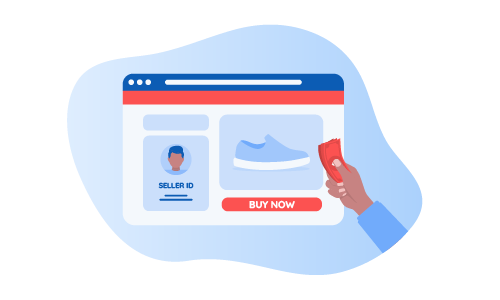
4. Marketplace/ platform-based/ brokerage / aggregator model. The business serves as a platform that brings together buyers and sellers, and takes a small cut of every transaction.
Pros:
- No major overhead or need to own/store stock
- Potential for rapid growth
- Gives platform operators access to user data
Cons:
- You need to reach a critical mass of buyers and sellers before others are tempted to join/engage.
- Reputation management can be tricky as the business has limited control over the quality of transactions.
Examples: Airbnb, Uber, eBay
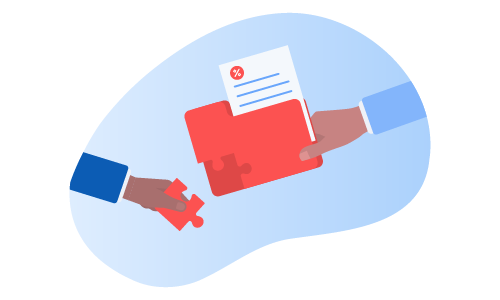
5. Razor-razor blade model. The business sells the base unit (a durable good) at below or only slightly above cost price and makes most of their profit from ongoing sales of complementary consumable products sold at a high markup.
Pros:
- Easy to attract new customers (as price of base product is low)
- Fairly steady and reliable revenue stream (as customers are “forced” to buy replacement consumables on an ongoing basis)
- Encourages brand loyalty
Cons:
- This model requires lots of capital to start out.
- Competitors selling replacement consumables that fit with your business’s base product can easily steal sales away from you.
- Customers might feel conned.
Examples: Gillette razors and razor blades, Xbox video game consoles and individual games, Printers and ink/toner cartridges
What is B2C marketing? Everything you need to know in a nutshell
Now that we’ve covered B2C business in general, it’s time to dig a little deeper and answer some more pointed questions: “What is B2C marketing?” and “How do you go about mastering it?”
B2C marketing refers to all the strategies and tactics a B2C business uses to promote and sell their products and/or services directly to individual consumers. More specifically, it covers all practices used to both acquire and retain customers—to bring in new leads (prospects) and nurture them through the decision-making process to convert them into loyal customers that keep coming back for more.
B2C marketing efforts tend to focus on building trust and cultivating desire, and they rely fairly heavily on the power of emotion and shared values to convince and persuade.
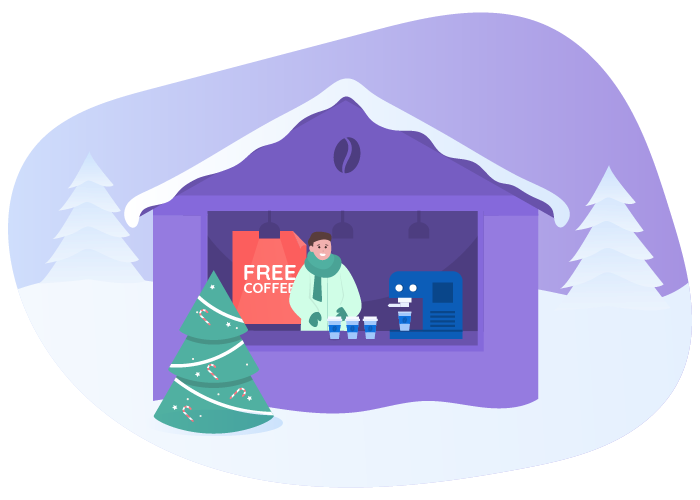
All of the following are examples of B2C marketing in practice:
- Organizing a promotional event to encourage prospects to try your new product
- Publishing blog posts on your company’s website to educate and entertain clientele
- Cold emailing prospective customers to promote your business’s new service
- Running a contest on Facebook to drive traffic to your website
- Installing roadside billboards to build awareness
- Sending personalized text message reminders to prompt customers to book their car in for a service
- Launching a loyalty app to offer customers mobile-exclusive discounts
A whole new world: How digital transformation is changing B2C marketing
Some of the above examples reflect more traditional forms of B2C marketing; others are newer alternatives that have emerged as the digital world has expanded and evolved. The rise of online platforms, channels, and technologies has completely revolutionized the way companies carry out marketing activities.
Marketers and business owners now have a heap of new benefits and opportunities, and it’s important to understand what these are so that you can leverage them appropriately in your marketing efforts.
We explore a few below:
A slew of new ways to engage. Thanks to digital transformation, the realm of marketing has welcomed a variety of new subdisciplines, including social media marketing, email marketing, content marketing, search engine marketing, and even augmented reality marketing. Brands can now engage with customers through blog posts, newsletters, tweets, online videos, podcasts, display ads, and many other powerful mediums.
Access to actionable data. The move to digital has made it possible for marketing professionals to carefully track user behavior and assess what’s working and what’s not. Businesses can now take advantage of the precise data available to them to streamline promotional activities, tweak ineffective strategies, and make more informed decisions about where they put their marketing money.
More control at each stage of the customer journey. Before marketing went online, it was difficult to know where a prospective customer was on the journey between awareness and purchase. Now, companies can use analytics to monitor buyers’ actions and can then intervene at each crucial point in the process to guide them along the sales funnel.
Greater personalization. B2C consumers of today respond best to tailored messaging, and digital software now makes marketing personalization easier than ever. Armed with information about customers’ inclinations, habits, likes, and dislikes, marketing professionals can send out targeted communications that win prospects over by speaking directly to their hearts and minds.
Enhanced interactivity. Once upon a time, B2C marketingwas all abouttalking to prospective customers; today, it’s more about talking with them. Digital mediums give consumers the ability to interact directly with brands, and marketing professionals and business owners need to prioritize two-way engagement, communication, and relationship management.
Automation. Digitization has made it possible to automate many marketing tasks and activities (think triggered emails) to save people time and effort and to improve the customer experience. In an automated online world, businesses can engage with consumers 24-7 and influence buying decisions in real time, even when the lights are out.
A quick how-to: 9 steps to B2C marketing success
Knowing how marketing has changed over the years will help you make the most of the latest trends and opportunities. But how do you actually do B2C marketing? What does putting together and carrying out an effective promotional plan entail?

We dive into specific channels and strategies you should be considering a little later in this guide, but first, on a broad level, here are nine steps you can follow to master the art of marketing.
1. Consider the “7 Ps of marketing.” You want to create value for customers while also making a profit. Giving careful thought to what’s known as the “7 Ps of marketing” will help ensure you achieve this objective and assist with your promotional efforts. Before launching any kind of marketing plan, take time to consider each of the following:
1.Product. The “thing” you’re offering customers
Questions to ask yourself
- What is our product/service?
- Is our product/service suitable for the market of today?
- Does our product/service meet customers’ needs?
2. Price. How you price your product/service
Questions to ask yourself
- What is the optimal price for our product/service based on the value it offers customers?
- How much are customers willing to pay for our offering?
- What are our competitors charging?
3. Promotion. The tactics you use to build awareness, create desire for your offering, and convert prospects into customers
Questions to ask yourself
- Which channels should we use to tell customers about our products/services?
- How do we want to talk to customers about our offering?
- Which features should we emphasize in our communications?
4. Place. Where customers interface with your brand and where your product/service is seen/experienced and sold
Questions to ask yourself
- Where do our customers prefer to shop (e.g., online, at a physical store)?
- How easily can our clientele access our product/service?
- Where else could we sell our offering?
5. People. The individuals who work for/with your business and are responsible for product development, customer service, and sales and marketing activities
Questions to ask yourself
- What skills do we need our employees and consultants to have?
- Do our employees do a good job of casting our business in a positive light?
- How do we retain standout staff members?
6. Process. The process you follow to deliver your service or to get your product into customers’ hands
Questions to ask yourself
- Is it easy for customers to do business with us?
- Do we repeatedly deliver the same standard of service to our clientele?
- How do we make the purchasing process more efficient?
7. Physical evidence. The external appearance of your brand — the environment within which products/services are sold and all visible branding (e.g., your website, product packaging, store layout, employee dress code)
Questions to ask yourself
- What do our customers see along the journey from awareness to purchase?
- Do the visual elements of our business inspire confidence in our offering?
- How do we improve our branding?
2. Identify and study your target audience. Before you can design B2C marketing tactics that appeal to customers, you have to understand what makes your prospects tick, what drives them to buy, and what their needs and wants are. Conduct in-depth market research to learn more about the demographics, preferences, browsing habits, and pain points of your target audience.
3. Segment your audience and develop buyer personas. Depending on your business, you might target various groups of people with slightly different needs and expectations. Take the time to segment your audience into categories and then create a detailed buyer persona (a fictional but research-based representation of a customer type) for each. This information will help you tailor and focus your marketing efforts so you drive conversions by saying the right things to the right people on the right platforms.
4. Conduct a competitive analysis. Who are your competitors? What differentiates your product/service from theirs? How are they currently marketing their offering? Do research to get answers to these questions so you can pinpoint what makes your business special (your unique selling proposition) and what you should be calling attention to in your marketing material.
5. Refine your understanding of the customer journey. What happens between the time your customers first become aware of your brand and the point of purchase? What happens beyond this? Map out the journey that buyers are likely to take when interacting with your company so you can deliver precisely what they need, at precisely the right time, each step of the way.
6. Choose appropriate B2C marketing channels. Use the information you have about your target audience and their habits to select marketing channels that’ll help you reach customers most effectively. Will you use Facebook? YouTube? Emails? Direct mail? Blog posts? Messaging apps? Flyers? Paid search? Display advertisements? Choose wisely and consider using multiple avenues to engage prospects.
7. Develop appropriate marketing strategies. Identify and employ tactics that a) excite and delight customers (focus on experience), b) build trust and loyalty, c) keep your brand top of mind, d) speak to customers’ emotional needs, e) maintain ongoing relationships with prospects, and f) help you connect with customers on a human level.
8. Define your goals and allocate marketing budget. What results do you want to achieve from your B2C marketing efforts? Do you want to increase web traffic by 20 percent over the next six months? Increase conversions by 15 percent by the end of a campaign? You need to set goals that are specific and measurable so you can ensure you’re on track to success. You’ll also need to assign a budget to each component of your marketing plan.
9. Track performance and tweak accordingly. Analytics allow you to closely monitor the performance of all your digital marketing activities. Track what’s working — and what’s not — so you can turn up the dial on effective strategies, abandon futile tactics, and generally respond with agility to move closer to your goals.
What’s the difference between B2C and B2B marketing?
Perfecting your B2C marketing approach also means understanding the fundamental differences between B2C and B2B marketing.
As mentioned previously, the aim of B2C marketing is to convince individual consumers to buy products and services for personal use, usually based on the benefits they expect to enjoy from their purchase or because of some sense of connection they feel to the brand and what it represents.

In contrast, B2B marketing focuses on decision makers at businesses and other organizations who make their purchasing decisions based on what’s best for the growth and sustainability of the for-profit and nonprofit organizations they represent.
Because purchasing aims and motivations for businesses differ from those of individual consumers, B2B marketing, as compared to B2C, tends to involve
- A longer decision-making process
- Multiple decision makers, often from more than one department
- Multiple sources of marketing content, each with its own aim and focus
- A focus on value in the form of money, time, or resources saved, or increased sales for the customer
- An emphasis on logical appeals
- Individualized pricing structures
Distinguishing B2C business from B2B business
| B2C selling | B2B selling |
| The buyer is an individual consumer purchasing a product or service for their own use/for their house old/friends/family members. | The buyer is a business/representative of an organization purchasing on behalf of senior management. |
| Generally just one or two people make the buying decision. | Multiple stakeholders make the buying decision collectively. |
| The sales cycle is typically short, and buying decisions are made fairly quickly (sometimes within minutes). | The sales cycle is typically quite long, and customers are often slow to make purchasing decisions. |
| The pool of potential buyers is usually large. | The pool of prospects is fairly limited. |
| The customer pool is constantly evolving — relationships with buyer are often short-lived, and one-off transactions are common. | Companies build long-term relationships with customers. |
| Purchase volume is usually low. | Purchase volume can be very high. |
| Customer spend is often quite low. | Customer spend can be in the billions. |
Apart from the differing motivations of the key audiences, another important difference between B2B and B2C marketing is that B2B purchasing decisions tend to be more complex.
More specifically, the B2B prospects you’re trying to turn into customers often need to build a business case for other stakeholders in their organization that what you’re selling will give them the most return on investment (ROI).
As a general rule, the larger the B2B purchase, the more people within the organization you’ll need to convince of your product’s value. Even if the purchase is small and can be authorized by a single contact within the organization, they will likely need to justify its value to the company’s bottom line.
This means that it typically takes a business much longer to make a purchasing decision than it takes the typical consumer. You’ll likely need to make multiple appeals over time.
In fact, most B2B decision makers report reading between three and five sources of content before even talking to a sales representative. For this reason, you should be prepared to produce more content for your B2B marketing program than for a B2C marketing strategy. These might include
- A brochure or flyer (most likely provided as PDFs)
- Case studies
- Webinars
- White papers
- Blog posts
- Sample pricing materials
You’ll need to have patience and develop a relationship over time as you provide more and more information to your potential clients. Along the way, you’ll be able to get a better sense of your potential partner’s internal needs.
What’s more, you need to focus your B2B marketing strategy on addressing how your product or service can benefit your customer’s bottom line in the form of resources saved or increased revenue. Because the focus is on the value your product adds to the purchasing organization’s bottom line rather than on the individual benefit to the consumer, B2B marketing content tends to be more technical, more focused on costs, and more individualized for each potential customer you approach.
All of this makes the B2B marketing process, as compared to B2C marketing, more robust, more time-consuming, and more expensive.
On the plus side, B2B entails far fewer potential buyers and a much narrower and specific audience. But it requires time, patience, and attention to detail to engage that audience.
Each approach — B2B and B2C — requires its own tailored tone and strategy. The following table outlines some of the basic differences between the most effective types of appeals:
B2B versus B2C marketing: Key differences in messaging
| B2B | B2C |
| Uses complex, technical information | Favors simple messaging |
| Logical appeals | Emotional appeals |
| Solution-focused | Benefits-focused |
| Content-rich | Concise |
| Micro-targeting to a small audience | Macro-targeting to a larger audience |
B2B vs B2C: Key differences in pricing
As briefly mentioned in our outline of the 7 P’s of marketing, pricing is an integral part of your brand’s story. A high price point can communicate to your potential customer that your brand provides luxury, high levels of service, and exemplary quality. A mid-range price might be seen as a sign of dependability and a good value-for-cost ratio. A low price point can communicate a bargain, efficiency, and innovation, or low quality and desperation.

These pricing perceptions are as true for B2C marketing as they are for B2B. However, because the nature and scale of B2B differs from B2C, your pricing model will likely be different as well. In many cases, you’ll customize your product for each large B2B purchaser, so a static pricing model isn’t always feasible. Here are some other areas of divergence.
1. B2B pricing is more negotiable
A B2B supplier might negotiate a different price for each of their business partners, whereas in a B2C environment this approach can be much riskier. If a B2C customer learns that someone else has gotten a better deal, they’re likely to feel cheated and look elsewhere for the product or service you provide.
You should also carefully consider how and when to offer discounts. Introductory discounts, for example, may lower your profit margin over production costs, but this might be worth it if you’re able to attract new, dedicated customers.
In a B2B environment, pricing is far more likely to be customized to account for volume discounts, length of contract, and degree of customization and customer support.
2. B2C pricing is more transparent
In the B2C world, maintaining clear, transparent pricing structures is the norm, and it can encourage repeat business, which can create marketing and sales efficiencies and increase your profit level over time.
On the flip side, in most professional environments, purchasing agreements between businesses are confidential. Getting insight into competitors’ pricing is often tedious and largely inferred from asking customers about their relationships with other organizations. This makes it more difficult to quantify the value of your product/service in comparison to your competitors. It also requires interaction with a B2B sales team, which can result in a more pointed conversation about value and the opportunity to begin a relationship with a prospect.
3. B2B innovators can charge more
If your product is unique or highly innovative, you can likely charge more for it, especially if you target equally innovative companies for B2B sales. Market leaders and outliers tend to be less cost-sensitive than more established companies, and industries with fewer competitors are more willing to absorb higher vendor costs than highly crowded sectors that have multiple options for suppliers.
4. Discounting is not an effective lure in the B2B sphere
In B2C, introductory or periodic discounting is a common way to lure customers away from competitors or encourage new customers to try your brand. In B2B marketing, however, the longer durations to make a sale tend to rule out discounting as a strategy. This means that prices tend to remain more stable.
When discounting is employed, it’s often in ways that benefit the supplier. For example, offering a client a discount for signing a longer contract benefits your bottom line by freeing you from the expense of renegotiating the sale for a longer period of time.
5. Sales typically has price-setting power in the B2B world
Because B2B pricing tends to be confidential, and because both the B2B supplier and buyer expect to negotiate an individualized price for each transaction, sales representatives tend to have more power over pricing in a B2B environment than they would if they were selling B2C.
If your sales force incentives aren’t designed to optimize pricing by encouraging representatives to ask for the highest possible price without losing the sale, you might find that your sales team is over-discounting. The best way to combat this is to clearly articulate your pricing strategy to all employees, while empowering your sales team to make reasonable adjustments to make sales.
B2B vs B2C: Key differences in social media and companion apps
Just as you need a website to launch a business in today’s market, it’s becoming increasingly important to have a companion mobile app so that you can engage customers where they are — on their mobile devices — with product updates and new features.
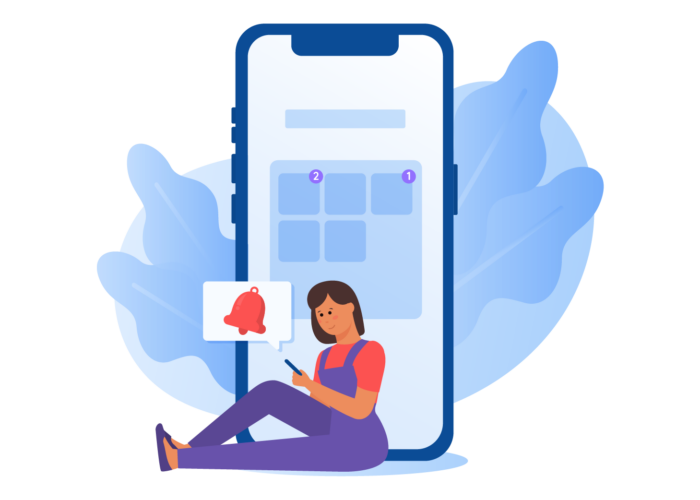
In the B2C space, companion apps can help drive sales by allowing your customers to complete automated orders. Your B2B customers are unlikely to use a companion app in a similar way because B2B decision making is simply too complex.
So why do you even need to develop a B2B companion app?
- Because mobile technology drives sales. According to new research, 80 percent of B2B buyers use mobile technology for work, and 60 percent report that mobile played a part in a recent purchase.
- Because it’s expected. The decision makers you’re trying to convince to buy your product are accustomed to using mobile apps to engage with their favorite consumer products. They’ll appreciate having a similar environment to explore your services.
- Because it keeps you on their minds. A mobile app will allow your B2B contacts to access information about your product at any time, even when they’re away from their desks, giving them more time to familiarize themselves with your product’s strengths.
- Because you’ll learn more about your buyers. Many mobile B2B (and B2C) apps are designed to encourage users to share their purchasing needs and desires with the supplier, information you can leverage to make a sale.
A good B2C app needs to provide a seamless user experience that mirrors the qualities of the brand it’s designed to sell. This can mean compelling or fun content, games, contests, virtual punch cards and other customer rewards, product information, news and celebrity endorsements, and remote sales capability.
An effective B2B app has a different function. Though robust product information and a high-quality user experience are important, B2B apps also should include
- Plenty of information so buyers can read up on your features whenever and wherever they want
- Customer relationship management (CRM) — for example, you may want to employ a “chatbot” to simulate an IM interaction
- Multiple payment methods, because while the purchasing decision will likely take place offline, younger employees increasingly prefer tomake purchases in a mobile environment
- Cloud-based information, which will cut down on storage costs and provide a more seamless user experience while allowing potential customers to gather more information on your product more quickly
Effective B2B marketing tips
Some organizations, including startups, may need to employ a mix of B2B and B2C marketing to grow their businesses. If your focus is B2C, and the amount of time and resources you have to devote to B2B marketing is limited, the following tips should allow you to develop an effective small-scale B2B marketing strategy:
- Focus on building long-term relationships.
- Plan for longer lead times between initial marketing interactions and purchasing decisions.
- Focus on logical appeals that communicate the value of your product.
- Be prepared to provide multiple forms of content with detailed information.
- Opt for information and authority over entertainment.
- Consider including some emotional appeals, especially when it comes to shared values like quality and integrity.
It may sound like a lot of work, but it’s worth it. B2B sales tend to come in higher volume, and, once organizations commit to a B2B relationship, that decision typically lasts longer than a direct-to-customer purchasing decision.
Top B2C marketing strategies
By now, you should have a solid understanding of your B2C business model and how it differs from any B2B activities that you may be responsible for. The next step in effectively promoting your products and services to consumers is building your formal B2C marketing strategy.
Whether you’re starting a new business or trying to take an existing one to the next level, a sound and well thought-out B2C marketing strategy is essential to growing your revenue and guiding your decision-making process.

Not to be confused with a marketing plan, which is more of an operational structure that lays out the timing and specifics around execution, a B2C marketing strategy is built on careful analysis and is a high-level approach to mapping out target markets, a value proposition, goals, how you’ll differentiate yourself from competitors, and what you’ll need from a resource perspective to accomplish key objectives.
In the fast-moving and ever-evolving world of business, it can be easy to get stuck in the nitty gritty of do, do, do: rolling out campaigns, tweaking pricing, and engaging third-party vendors to carry the workload when you don’t have the resources to shoulder it yourself.
But forging ahead without the overriding directional concept of a marketing strategy is a bit like putting the cart before the horse. While you may be able to accomplish a lot, without taking time to stop, back up, and do the work necessary to build a careful and research-backed marketing strategy, you may find yourself going down the wrong road — or worse, hitting a dead end.
In business terms, this means you could waste hundreds of thousands of dollars on engaging the wrong audience with the wrong messaging through the wrong channels — not to mention the countless hours employees would have devoted to failed initiatives.
What’s more, while you were “chasing the shiny objects,” implementing poor marketing tactic after poor marketing tactic, or trying to capitalize on every new hot marketing trend, you might have missed out on massive opportunities and lost valuable ground to the competition.
How to create a B2C marketing strategy
A marketing strategy should not only be based on solid research (rather than intuition or experience), but it should also be built through a collaborative process that involves key stakeholders across the business.
Once you’ve committed to engaging the right people and conducting the right kind of investigation, follow these five critical steps to build an effective and flexible B2C marketing strategy.
1. Identify your goals
Setting concrete objectives is the first point on the agenda of a good marketing strategy, and as any college-level marketing student can tell you, targets should always be SMART (specific, measurable, achievable, relevant, and time-bound).
Your marketing goals shouldn’t exist in a vacuum; they should be linked to the business’s overall objectives. This is fundamental to getting the support of the higher-ups and to measuring success against the company overall.
For example, if one of your organization’s goals is to increase revenue from existing customers by 30 percent, then the following would be good and bad examples of marketing goals:
Bad marketing goal: Generate 500 new sales-qualified leads through content marketing campaigns and organic acquisition efforts over the course of the year.
Why is this a bad example? Because generating new leads isn’t aligned to the business objective of increasing revenue from existing customers.
Good marketing goal: Launch six new content marketing campaigns and 12 new email campaigns to provide more value to customers, make them aware of supplementary product offers, and increase overall lifetime value by 12 percent.
2. Get to know the competition
Studying the competition is one of the most crucial activities that you can do as a marketer building a successful strategy.
Investigating other businesses’ weaknesses and strengths, and defining and better understanding the industry overall, is known as competitive analysis. As the U.S. Small Business Administration puts it, “[It’s] key to defining a competitive edge that creates sustainable revenue.”
While there are a number of approaches to conducting a competitive analysis, like Porter’s Five Forces or the Competitor Array, all of these models have one thing in common: They’ve been proven to help businesses perform better.
Understanding others’ behaviors and actions can not only better protect the health of your organization, it can also help you identify potential opportunities that can translate directly to more revenue and a stronger market position.
3. Understand your target audience
Knowing your customers is as important as knowing yourself — your products and services, that is. And this requires some serious market research.
The more you understand who your customers are, the products they buy, and why they buy those products, the more you’ll be able to fine-tune your marketing efforts and create personalized campaigns for them.
For starters, look at existing demographic, income, and trade info from government organizations to begin gathering data. Then work with research professionals to build surveys or conduct interviews and focus groups to get into the nitty gritty.
You should come away with not just a high-level profile of your customers but insight into their motivations for making purchases as well as their expectations for products and services.
4. Lock in your marketing tactics, programs, and campaigns
Once you’ve set your objectives, drawn up a picture of your competition and the state of the industry, and dug into your target audience, it’s time to outline the tactics, programs, and campaigns that will allow you to execute on all the work you’ve done up until this point.
In a nutshell, marketing tactics are the actual actions you’ll take to achieve your objectives. They may include rolling out a membership program, setting in motion a retargeting campaign, or even organizing a few big events.
The tactics that you choose to move forward with should align with your goals, and they should be based on the customer and competitor data you’ve collected. For instance, perhaps you’ve found that your target audience primarily uses a particular social media channel — or maybe it’s come to light that the your number-one competitor has generated lots of positive press and subsequent sales from a big conference they organized.
By drawing on existing information, you can outline the marketing tactics you think will work best, keeping in mind that these are flexible and should be regularly evaluated and adjusted according to the results of your efforts.
5. Pinpoint your resource needs
Good marketers know that you have to spend money to make money, but the best in the business understand how to build budgets rooted in real numbers and operational costs.
Outlining your resource needs from a financial perspective — but also from a personnel and technology stack perspective — is key to successfully creating and implementing your marketing strategy.
To do this, work backward from your marketing goals and tactics, identifying how much you’ll need to invest in each channel, both from a monetary and manpower point of view, to hit your objectives.
Factor in any additional operational costs, like software critical to your sales funnel, third-party vendors essential to shouldering the workload, and even travel expenses.
Keep in mind that plenty of technology options can automate many of your workflows and scale your marketing efforts without having to add staff (see the chart below for some great options):
Buffer. Coordinates and times the release of marketing announcements across multiple platforms
Price: Range: $15, $99, $199, $300 per month depending on the size of your business
Hootsuite. Provides a dashboard to map social media and track engagement statistics across platforms
Price: $120 per user per month, or $599 per month for up to 5 users
Facebook Pages. Allows you to upload images and update your FB business page remotely
Price: Free
Canva. Famous for providing an affordable way to create quick, professional looking graphics; also allows you to easily upload graphics and prototypes to multiple social media platforms
Price: Basic package for free; Canva Pro for $12.95 per user per month, $9.95 per user per year; the deluxe Canva Enterprise offers custom pricing
Clover. Supports hands-free payment, tipping, and customer loyalty programs
Price: Fees begin at $9.95 per month, usually bundled with rental or purchase of hardware
Mention. Monitors the web for “mentions” of your business and products, so that you address issues and counter negative information as needed
Price: Starts at $29 per month
Top marketing tactics and techniques
Today’s top marketing tactics and techniques are largely influenced by digital transformation and the way businesses reimagine their use of technology.
The massive expansion of the internet, with its multitude of channels and platforms, and the advent of mobile technology and wearables that allow consumers to access the internet from anywhere at any time should be front and center for every B2C marketer, no matter your vertical or your product or service.
Here are a few best practices to keep in mind as you define your marketing tactics and allocate an appropriate budget:
1. Think mobile first
Americans are now even more glued to their mobile devices than they are to television, with individuals spending an average of just under four hours on their phone or tablet every day. One in five people living in this country have “smartphone-only” internet access, which means their phone is their only method of accessing the web, and 37 percent say they mainly access the web with their smartphone.
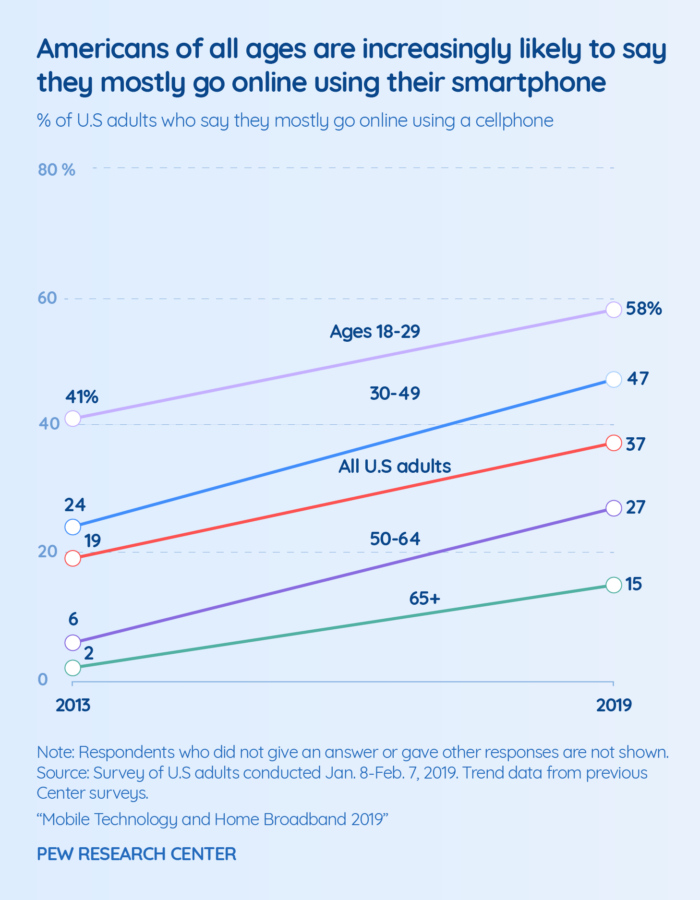
If you’re not tailoring your marketing efforts to include mobile initiatives, you’re making a grave mistake, especially since the largest demographic segment of consumers (Millennials) is particularly reliant on their phones.
For one, that means making sure your website and all other forms of digital communication are mobile friendly, meaning the mobile experience is seamless and easy.
It also means investigating native mobile efforts, like mobile apps, and taking into account that most people will access social media from their mobile devices.
2. Prioritize marketing personalization
We live in an era of instant gratification, and that means that as a marketer, your messaging needs to be relevant and engaging. Enter marketing personalization, which involves communicating with customers in the ways they prefer and offering them things they actually want by aligning your efforts with their behavior.
As noted by McKinsey, marketing personalization can cut acquisition costs in half, increase revenue by up to 15 percent, and make overall marketing spend 10 to 30 percent more efficient.
To appropriately implement personalization efforts, you need to first have the tools and technology to gather data about certain customer signals, like how they browse online or scan social media. Then, it’s a matter of creating individual messages that map to those customer signals.
Certain marketing automation technology can help make these kinds of efforts more scalable for larger companies.
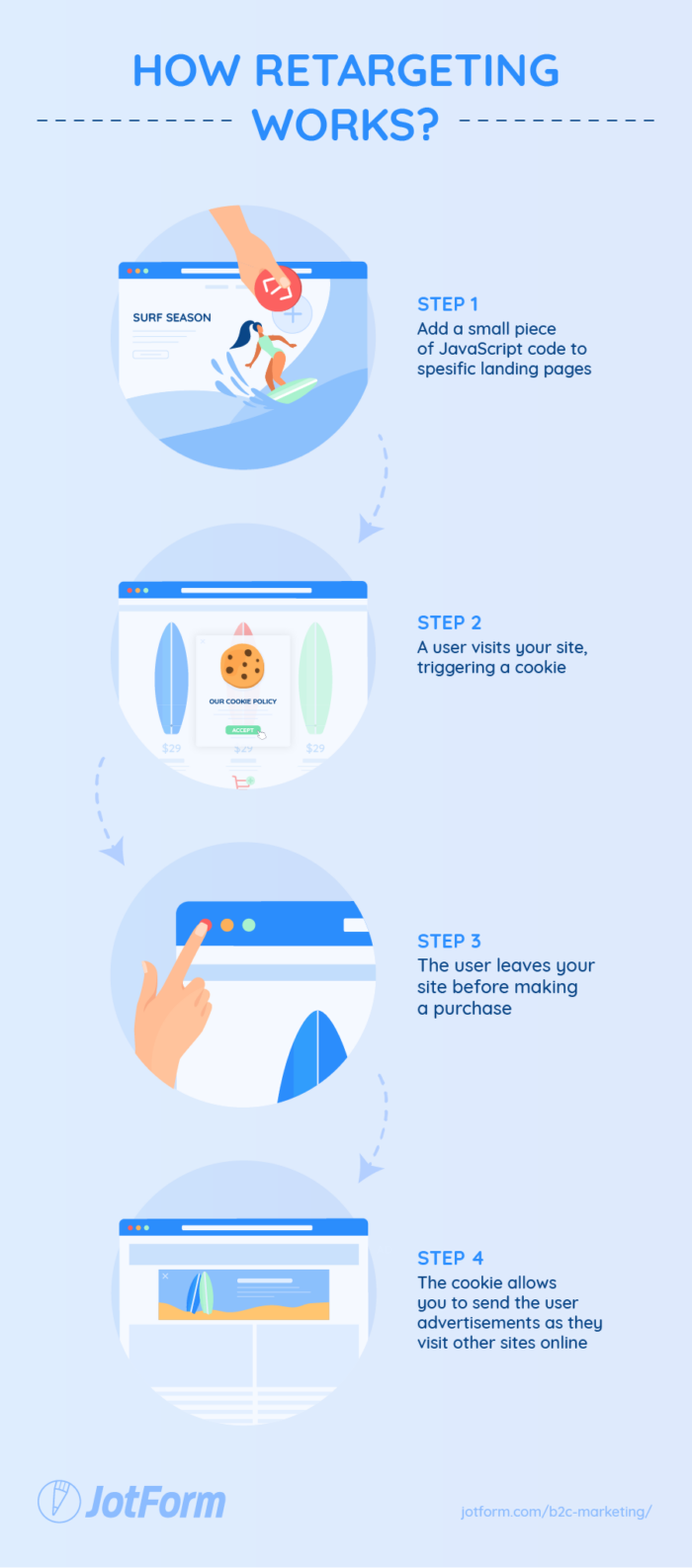
3. Reap the benefits of retargeting
Retargeting, the act of redisplaying online advertisements to anyone who has visited your website, is one broad example of personalization.
According to the Interactive Advertising Bureau (IAB), over 90 percent of marketers reported that retargeting ads performed as well as or better than similar search, email, and display ads.
4. Engage your customers with events and conferences
Event marketing is a prime way to captivate your current and potential customers and engage them in a real-world, interactive setting all while building your brand and teaching them about your amazing product and service offering.
When done right, this kind of experiential marketing tactic can have long-lasting effects that both make attendees more loyal and leverage their networks if they share with their friends via social media or even word of mouth (fuelling new customer acquisition).
Of course, to effectively pull off a memorable and effective event or conference, you need a detailed and extensive marketing plan to not only draw attendees and generate buzz, but also to generate leads and get a return on your investment. JotForm makes this last task particularly quick and easy, giving you the power to build custom online forms and capture all the information you need to better market to your customers.
5. Boost loyalty with a membership program
A membership program, also known as a loyalty program, is the ideal marketing tactic for any business committed to improving customer retention and boosting lifetime value (the profit a company can expect from the entire lifetime of a customer).
These kinds of initiatives generally work by rewarding customers with perks based on the number of purchases they make. There are all kinds of opportunities to get creative with how you roll out a membership program. For example, you may want to partner with another business to give customers added benefits, or perhaps you could gamify your system or create a community that adds another kind of value for loyal members.
However you decide to implement this program, keep in mind that the main goal is to increase customer spend, which is more of a sure thing as existing customers are 67 percent more likely to spend more than new customers.
6. Activate an ambassador program
In a world where consumers are more and more discerning about the content and messaging they consume, leveraging the power of committed customers who can promote your brand can be an effective way to drive acquisition and build brand awareness.
An ambassador program helps organize and guide these advocates, giving them information about your goals and the high-level subject matter you’d like them to focus on.
Most brand ambassadors’ main medium is social media, where they can help you establish credibility with their audience of followers.
7 outstanding B2C marketing examples and campaigns from major companies
Even the most well thought-out marketing strategy and carefully considered marketing tactics can fail if they’re not executed effectively or implemented in a creative way. Today, organizations have to stand out and differentiate themselves. It can be difficult to come up with good campaign ideas and assets — especially if you don’t have the world’s largest marketing budget or an entire team dedicated solely to this area of the business.
In this case, it’s a good idea to look for inspiration from some big brands that are best in class in their industry. It’s entirely possible to borrow big ideas to fit your marketing needs or just use their approaches to get the creative juices flowing.
Take a look at these outstanding B2C marketing examples to get started building your own brilliant effort.
1. REI’s “Expert Advice” section for a great example of B2C SEO marketing
Everyone knows that content is king when it comes to SEO and B2C marketing, but when you’ve got a lot of competitors in your category, like REI does, it’s even more challenging to stand out and rank highly in the search engine results pages (SERPs).
To drive traffic for the very competitive keyword category of camping and outdoor activities, REI added an Expert Advice section on their website, which features over 500 keyword-rich targeted articles aimed at ranking for mid-tail and long-tail terms.
These terms are specific search queries that tend to have a lower search volume (i.e., “how to waterproof a tent” and “what kind of bike should I get”). They also tend to be easier to rank for because they don’t have as much competition. In addition, they help to build category context for Google, which makes it easier to rank for more competitive, higher volume short-tail terms, like “camping” and “fitness.”
REI’s SEO approach brings 600,000 visitors to this section of their site on a monthly basis, all of which they can then convert from interested readers to buyers.
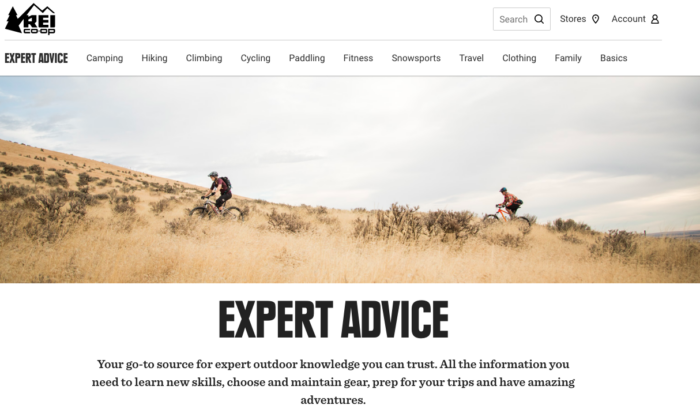
2. Airbnb for tip-top B2C marketing personalization
An increasingly important aspect of B2C marketing is personalization, which allows companies to target their audience more accurately and create custom messaging that leads to greater engagement as a reward for relevance.
Effective personalization relies on data, so the more information you can get about your customers and their interests and previous behavior, the better able you’ll be to create campaigns and assets that will resonate with them and motivate them to make a purchase.
Airbnb uses a pretty simple form of personalization in their marketing emails by leveraging user contact details, home location, and behavior on the main website. The end product is an email that addresses users by name and suggests they take a trip to the most popular getaway destinations from the city where they live.
Readers who receive this kind of communication will be more likely to engage because they feel like it directly applies to them.
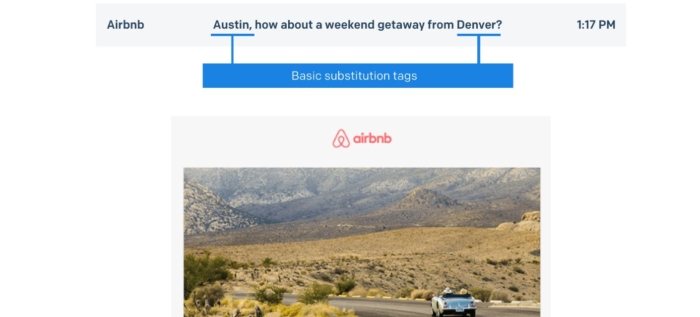
3. Fashion Nova for a five-star example of a B2C ambassador program
Fashion Nova is one of the fastest growing apparel companies in the world. They’ve never had a fashion show or run an ad in a single magazine, yet they’re as widely searched for online as Louis Vuitton and Chanel.
The company’s marketing has mainly been on Instagram, where brand ambassadors and social media starlets, like Katerina Themis and @XTYDime, have created buzz through digital word of mouth using the hashtags #NovaSquad and #NovaBabe.
The organization has a formal program that calls on customers and ambassadors alike to post photos of themselves wearing their Fashion Nova items and tag the brand with the appropriate hashtag. This creates excitement for new inventory and embodies the inclusivity that’s part of the company’s brand message. Fashion Nova then reposts these posts, giving their advocates an opportunity to gain more exposure and validation for their own accounts.
Gen Z and Millennial audiences, which the teen clothing brand targets, are less likely to trust traditional advertising and more likely to look for “real” endorsements from their peers and trusted influencers. Accordingly, Fashion Nova was able to reach potential customers where and how they want to be reached, and today, they have over 16 million followers on Instagram.

4. Waze for awesome B2C content marketing
Compelling content doesn’t have to live on your website or leverage SEO best practices to acquire new customers. Another form of content marketing enables B2C professionals to create engaging assets and then partner with a trusted source that can spread the word to their audience and increase your reach while building brand awareness.
Waze did exactly this when they worked with the New York Times to create a piece of sponsored content about interesting driving trends. The piece was also interactive; it included quiz questions where people could test their knowledge on current trends.
You don’t have to partner with a major outlet to accomplish this goal — consider local organizations that align with your mission, and think about where you could reach the right audience using the data you have on your industry.
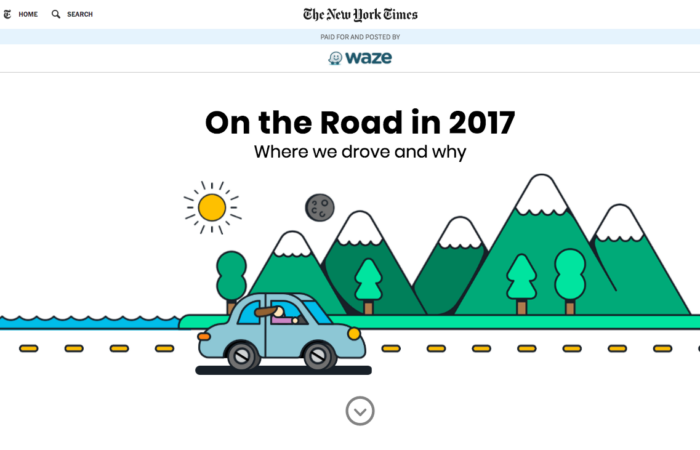
5. Ikea for B2C social media
Everyone knows about Ikea at this point, but not many can say that they have the entire catalog memorized by heart. When Ikea found a woman who had done exactly that, they partnered with her to create a Facebook Live event, which ended up attracting thousands of views from people who wanted to test her knowledge.
Ikea got to re-introduce their entire catalog to their social audience, and by taking advantage of user-generated content, they got social proof that their product was universally beloved.

6. Sephora for a super B2C marketing strategy that leveraged a loyalty program
A good loyalty program can help break barriers to entry for customers if, say, the cost is too high or the product isn’t considered essential. It can also motivate additional purchases.
Makeup company Sephora, which has around 17 million members in their Beauty Insider rewards program, keeps customers coming back for their high-priced makeup because their loyalty points system makes it accessible.
Like a traditional model, buyers earn points for each purchase, but they can use them in a number of different ways, whether it’s redeeming points for limited edition products and exclusive events like in-store tutorials, or using points additional seasonal discounts and free shipping. The Sephora loyalty program is also tiered, granting more and better freebies to those who spend more, which further incentivizes customers to keep shopping.
Having different ways to use points gives customers access to good deals without devaluing the Sephora products, which is a real win-win!
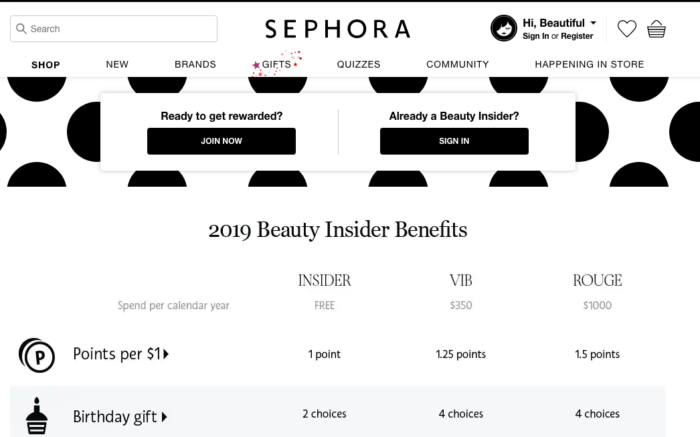
7. Best Buy for an excellent B2C marketing retargeting strategy
When it comes to online shopping, the checkout cart is probably the worst place for marketers because that’s where most conversions die. About 88 percent of purchases are abandoned at the final stage of the purchasing process, so this might actually be the most important for remarketing.
Best Buy does this quite simply by retargeting shoppers who have abandoned carts with a gentle nudge in the form of ads asking them if they’re ready to check out. Consider whether email, social media, or your website are the right platform for this end-of-funnel remarketing, and use your organization’s unique voice and character to give that nudge.
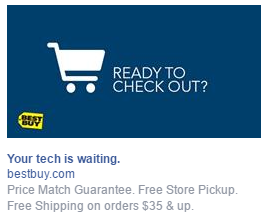
The most effective B2C marketing channels
Once you have a solid understanding of what you’re going to say and to whom you’re going to say it, the next critical piece in the B2C marketing puzzle is identifying where you’re going to distribute your promotional material. In essence, you need to know which marketing avenues — or channels — will help you execute on your overall roadmap.
Choosing the most effective marketing channels for your business depends on your goals, your audience, and your budget, but the four listed below have proven time and again to be the areas that can give you the most bang for your buck.
Paid search: Leverage PPC, or SEM, and display ad marketing
Paid search, often referred to as pay-per-click (PPC) or search engine marketing (SEM), involves paying for advertisements on search engines like Google and Bing.
This form of B2C marketing is measurable and, if optimized correctly, can be especially lucrative and effective.
In paid search, marketers bid on keywords relevant to their business to win the opportunity to display their text-based advertisements on the associated search engine results pages (SERPs). The cost of each keyword depends on a handful of variables, including your bidding strategy, Google’s Quality Score, and competition for that particular keyword.

A search engine results page is just what it sounds like — the page a search engine shows in response to a particular keyword query. The main components of a search engine results page are paid listing results, organic search query results, rich media results, and a knowledge graph, though not all search engine results pages contain all of these components.
To maximize your investment in paid search, it’s important to conduct keyword research to find the keywords most relevant to your business, investigate the cost per click that top performers are paying for each keyword and see how that compares to your budget, create brilliant and clickable ads and effective landing pages, and track all of the metrics carefully to make sure your ad spend drives the return on investment you want.
Another form of paid search is display advertising, which gives marketers the opportunity to place banner advertisements on websites that aren’t their own. Unlike advertisements on SERPs, these promotions are visual and even dynamic. Again, to get the most bang for your buck, you should make each ad as engaging as possible and carefully monitor analytics to get an idea of which ads are performing best and where you may need to experiment further.
SEO: Overview of content marketing and organic acquisition
The counterpart to paid search marketing is search engine optimization (SEO), which is the art of creating content pages on your website that rank as high as possible in the SERPs for a given keyword.
The best part of this particular channel is that it’s absolutely free, gratis, no cost!
However, to implement this effectively, you need to understand the many ins and outs of Google’s ranking algorithm, which dictates where your web pages appear in the SERPs for a given keyword.
Those who take the time to understand how to create quality content that aligns with both on-page and off-page ranking factors will enjoy huge ROI and great success in new customer acquisition.
This effort forms one part of content marketing, which is the process of building and distributing content to strategically promote a brand, drive acquisition, encourage conversion, and increase loyalty among potential and existing customers.
B2C email marketing: What it is and the one way you should always use it
True to its name, email marketing is the act of using email as a channel to promote your services, build relationships with customers, and create better brand awareness.
Like SEO, email marketing can be especially useful for small businesses with slim budgets because it can be absolutely free. On the flip side, if you do have money to put behind it, there are ways to leverage this outlet (e.g., purchasing email lists) to get greater returns.
Regardless of what you have to spend, email is a channel that all businesses should use to keep their customers informed, from simply providing fundamental transactional information to alerting potential and committed customers to new product or service developments.
Social media marketing: A strategy that works
As you may have guessed, social media marketing involves using social media platforms, like Facebook and Instagram, to further your promotional efforts.
And like email, there are opportunities to leverage this channel both for free and with a paid strategy. No matter what, it’s an essential element of a complete marketing plan. Case in point: Nearly 3.5 billion people use some form of social media every day, with digital consumers spending roughly 2.5 hours scrolling through posts and engaging in messaging.
At the very least, your social media marketing strategy should include a basic digital presence. You should have profiles on the platforms that are most relevant to your audience and that can provide the best opportunities for customer engagement.
You can maximize the value you get from social media by implementing a well thought-out strategy with these steps:
- Map out your social media marketing goals and align them with your overall marketing objectives.
- Identify which social media platforms best align with your target audience.
- Pinpoint the key social media metrics that will illustrate success, including measuring paid campaigns if relevant.
- Create compelling and engaging content.
- Track results and optimize your efforts accordingly.
Advocate for your brand with affiliate marketing
Affiliate marketing — the process of creating partnerships, both paid and unpaid, with other publications, brands, and influencers on the web who agree to promote your products or services — is another nontraditional digital method that B2C businesses can explore to boost brand awareness and drive acquisition.
Most of the time, these partnerships are paid and based on performance. That means you only pay your affiliates a commission when their audience members take an agreed-upon action, like clicking a link, making a purchase, or signing up for an email newsletter (read more about how JotForm makes lead generation quick and easy).
This method of marketing places much of the responsibility of promotion on the affiliates, giving them more carte blanche to promote your products to their audience in the ways that they know will be most successful.
On the flip side, as an effective B2C marketer, it’s essential that you do three things to ensure your efforts in this arena give you the maximum amount of exposure and return on investment:
- Carefully research affiliates and identify the ones most relevant to your target audience.
- Constantly track success metrics to ensure affiliates are performing and generating the quality of business you want.
- Protect your brand identity by monitoring the messaging that affiliates and influencers use to engage audiences.
Apart from paid affiliate marketing, there are also unpaid affiliate relationships.
This may take the form of social media influencers who agree to mention or promote your product in exchange for some sort of cross-promotion or perk. Alternatively, it may take the form of a content exchange, where you provide the affiliate with some sort of valuable content that they can use to boost their audience engagement and traffic while more discreetly educating users about your product or service — even encouraging them to visit your website or make a purchase.
